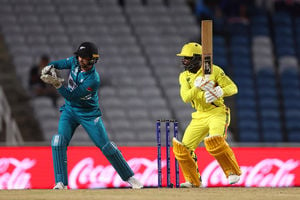
Writer: Robert Okot. PHOTO/FILE
Just before the Cricket Cranes left the Caribbean from a somewhat fulfilling experience, having participated for the first time in the ICC T20 World Cup, reports of a potential corrupt approach from a former Kenya international were all over. Fortunately, the incident seems to have been handled swiftly as the player is reported to have informed ICC’s Anti-Corruption Unit (ACU) in time.
In a country like Uganda where corruption scandals take turns in dominating media stories, being approached with a corruption offer and turning it down would certainly cause laughter and ridicule towards the person reporting.
For decades now, sports have attracted lawbreakers. The scope they offer for betting and match-fixing makes them a lucrative financial stream. In the 2022 period, it was found that there were more than 1,212 suspicious matches across 12 sports and 92 countries. Football topped the list with 775 suspicious matches, while cricket came sixth with 13 suspicious games.
It is no secret that voluminous betting takes place in India on cricket as nearly Rs1,000 crore (Shs10b) is reportedly punted on a single Indian Premier League (IPL) game. By 2016, the size of India’s illegal betting sector was approximately $150b (Shs560 trillion), with more than 80 percent of the illegal betting generated by cricket. It is, therefore, not surprising that India is also a big contributor to the list of players banned by the ICC.
Most top players earn too well now to succumb to the lure of shady money, unless they are intimidated into mischief. But because cricket happens throughout the year at various levels and in various parts of the world, bookies find a way.
What is interesting about any match and spot-fixing discussions is the evidence from some of the involved individuals that the agreed ‘fixes’ did not always work. South Africa’s Hansie Cronje, for instance, admitted that the games he was paid to fix did not produce the intended result, one reason being that the two other players involved, Herschelle Gibbs and Henry Williams, played well in the match.
On the other hand, Lou Vincent, a former New Zealand batter, stated that he was paid to score 15-20 runs in the first few overs before getting out. However, as he pointed out on one occasion, he danced down the wicket with the intention of getting out stumped, only to accidently hit the ball for six after “the ball hit a footmark”. He also stated that the mistake was compounded when he accidentally edged the next ball for four, ending his innings with an excessively high score for those who knew about the fix to make any money.
In the Salmon Butt v ICC and Mohammad Asif v ICC cases, the Court of Arbitration for Sport (CAS) panel noted that in many sports, life bans had been imposed as the appropriate penalty for corruption, which is why CAS considered Butt and Asif’s bans to be lenient. While the ICC did not consider life bans to be appropriate in these two cases, cricket authorities have certainly been willing to give life bans in other cases, such as those involving Cronje.
While it may seem to be of little consequence to someone like Lou Vincent, who did not report the matter until after his retirement, the ban includes any involvement in cricket, such as coaching, which can provide post-career employment and income for players.
Cricket is not the only sport facing problems related to match and spot-fixing and very unlikely it can ever be totally eliminated.
However, the measures implemented by the ICC such as the formation of the ACSU and the Anti-Corruption Code, create a framework where incidents can be dealt with, and appropriate sanctions be imposed.
The writer, Robert Okot, is an international rights and non-profit law attorney. He also plays for Africa Cricket Club.

